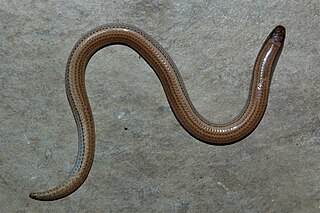
Skinks are lizards belonging to the family Scincidae, a family in the infraorder Scincomorpha. With more than 1,500 described species across 100 different taxonomic genera, the family Scincidae is one of the most diverse families of lizards. Skinks are characterized by their smaller legs in comparison to typical lizards and are found in different habitats except arctic and subarctic regions.

The Florida sand skink is a species of lizard in the family Scincidae, the skinks. It is endemic to Florida in the United States.

Scelotes is a genus of small African skinks.

Typhlacontias is a genus of legless, burrowing skinks in the family Scincidae, a genus endemic to Sub-Saharan Africa. Its sister group is the clade consisting of the genera Feylinia and Melanoseps.

The western skink is a species of small, smooth-scaled lizard with relatively small limbs. It measures about 100 to 210 mm in total length. It is one of seven species of lizards in Canada. They spend much of their day basking in the sun. Their diet ranges widely, including spiders and beetles. Western skinks will bite if grasped and will flee if they feel threatened. It is a common but secretive species whose range extends from southern British Columbia and throughout Washington, Oregon, Nevada, Utah, Idaho, and Wyoming and into western Montana and northern Arizona and Missouri. They can also live in some areas of Texas It is widespread in northern California but primarily restricted to the coast in central and southern California. Found in a variety of habitats, this lizard is most common in early successional stages or open areas of late successional stages. Heavy brush and densely forested areas are generally avoided. Western skinks are found from sea level to at least 2,130 m (7,000 ft). This diurnal reptile is active during the warm seasons.

The prairie skink is a species of skink endemic to the prairies east of the Rocky Mountains in North America. It is one of only seven species of lizards that occur in Canada.

Chalcides bedriagai, commonly known as Bedriaga's skink, is a species of lizard in the family Scincidae. The species is endemic to the Iberian Peninsula. It usually lives in sandy areas with sparse vegetation and good ground cover. It can also live in open woodland and burrow into loose soil. Females of the species give birth to live young. This skink is active during day and dusk, and it is very timid. It may reach about 16 cm (6.3 in) in total length, and it has five digits on each foot. It preys on insects, spiders, slugs, and woodlice.

The western three-toed skink is a species of lizard with tiny legs in the family Scincidae. It is found in the Iberian Peninsula, southern France and parts of northwestern Italy. Its natural habitats are temperate forests, temperate shrubland, Mediterranean-type shrubby vegetation, temperate grassland, sandy shores, arable land, pastureland, and rural gardens. It was first described 1829 by the French naturalist Georges Cuvier. The generic name comes from the Greek "chalcides" meaning 'copper' and the specific name is derived from the Latin "striatus" meaning 'streak'.
The great desert skink, also known as Kintore's egernia and by various names including tjakura in various Aboriginal Australian languages, is a species of skink, a lizard in the family Scincidae. The species is endemic to the western half of Australia. It is a burrowing lizard and extremely social.

The desert rain frog, web-footed rain frog, or Boulenger's short-headed frog is a species of frog in the family Brevicipitidae. It is found in Namibia and South Africa. Its natural habitat is the narrow strip of sandy shores between the sea and the sand dunes. It is threatened by habitat loss by such factors as mining and tourism.

The eastern striped skink is a species of skink found in a wide variety of habitats around Australia. They are long-tailed, fast moving skinks that are quite large, growing to a maximum length of about 30cm. This skink is mostly brown with a white-edged black stripe running down the length of its back and tail with broad brown stripes along the side of the body with rows of white spots. The sides become lighter, turning into an off-white colour towards the underside of the skink, running from the groin to the chin. The striped skink is similar in appearance to the spotted-back skink with the main identifying difference being the solid stripe running down the back of C. robustus whereas C. uber orientalis has a row of dots.
Vivian Frederick Maynard FitzSimons, born in Pietermaritzburg, was a notable herpetologist in South Africa. Also, he contributed to the collection of spermatophyte samples for the National Herbarium which has become part of the South African National Biodiversity Institute at the Pretoria National Botanical Garden. In 1937, together with Anna Amelia Obermeyer, he collected some of the earliest plant specimens from the Eastern Highlands of Rhodesia.
Haacke's legless skink, also known commonly as Brain's legless skink and Brain's blind legless skink, is a species of lizard in the family Scincidae. The species is endemic to Namibia.
The ghost skink is a species of skink endemic to Australia. Commonly known as the Ghost skink because of its faded dorsolateral banding when compared to other banded Erimiascincus species that have well-defined dorsolateral banding on their backs.
Typhlacontias johnsonii, Johnson's western burrowing skink, is a species of lizard which is found in Namibia and Angola.
Typhlacontias kataviensis, the Katavi blind dart skink, is a species of lizard which is endemic to Tanzania.
Typhlacontias punctatissimus, also known commonly as the dotted blind dart skink, the speckled burrowing skink, and the speckled western burrowing skink, is a species of lizard in the family Scincidae. The species is native to southern Africa. Three subspecies are recognized.
Typhlacontias rudebecki, Rudebeck's western burrowing skink, is a species of lizard which is endemic to Angola.











